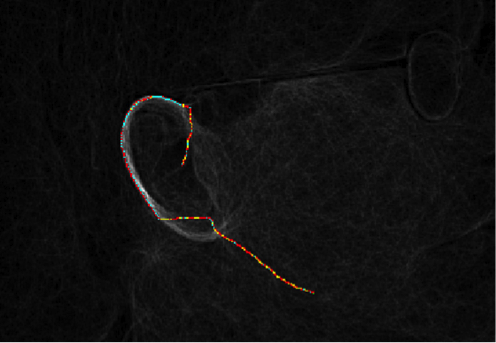
Image derived from “Ears Could Make Better Unique IDs Than Fingerprints”, Wired (US) November 2010
The CSPC research in image processing and computer vision spans techniques from preprocessing, to feature extraction (especially moving ones) and on to image analysis. Our approaches to feature extraction have extended classic technique, such as active contours/ level sets and the Hough transform, and we have started totally new approaches. The new approaches have been phrased around using analogies such as water, heat and light. These analogies simplify the problems and enable alternative methods of feature extraction. Our main application areas have been in biometrics, in remote sensing and in medical image analysis. We have a long record in biometrics, starting in automatic face recognition and have since conducted some of the earliest work in recognising people by their gait and by their ears. We continue to work in these areas and are now developing soft biometrics, in which we learn from human labelling to augment or even replace the automatically derived measures.
The main academic staff on the research team are Dr. John Carter, Dr. Sasan Mahmoodi, and Professor Mark Nixon. Currently, we have around 20 students and research staff working on various aspects of computer vision and image processing. Currently our team are working on projects which include: dynamic level sets, wavelet based ear biometrics, quality to improve biometrics, using gait to prime face recognition, context aware superpixels, texture feature extraction, 3D gait modelling and spoofing, 3D gait reconstruction, comparative soft biometrics, soft biometrics in computer vision, and on light based analogies for object extraction.
We collaborate here with the Institute of Sound and Vibration Research and with the Schools of Geography and of Psychology, together with international institutions. Our financial supporters have included the EPSRC, the EU, DARPA (USA), ARL (USA) and the UK Home Office together with industry. Our facilities include a well-stocked computer vision library, a compute cluster, storage servers and a vision laboratory and the biometric tunnel. You'll find our publications listed under the team’s students and academic staff; our textbook Feature Extraction and Image Processing in Computer Vision has just reached its 3rd Edition (Academic Press 2012). Naturally this page is space-limited and we have wider interests: you're welcome to contact us should you be interested in topics other than those listed here.
Biometrics | Feature Extraction | Medical Imaging
